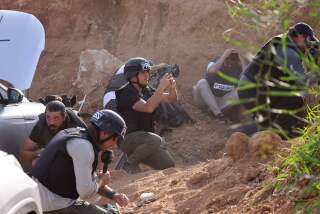Rolling Robot Reporters Into War
- Share via
CAMBRIDGE, Mass. — Wanted: aggressive war correspondent with interview skills, satellite phone. Mobility required in hostile, rugged terrain. Pay: None. Solar panels a plus.
Frustrated by what he considers a dearth of solid news from the Afghan conflict, a Massachusetts Institute of Technology researcher has set about trying to build a roving multimedia reporter.
A remote-controlled robot could help journalists troll for news in the world’s hot spots, witnessing battles at close range and even conducting interviews, said Chris Csikszentmihalyi, director of the Computing Culture group at MIT’s Media Lab.
The invention, modeled on NASA’s Mars Explorer, not only would help keep reporters out of the line of fire but also could help overcome the U.S. military’s restrictions on press access, the researcher thinks.
Although only a small leap from technology already in use, a roving robot reporter that can acquire and transmit audio and video--even interacting with subjects--is a terrific idea, said John Pavlik, a Columbia University journalism professor whose work centers on the intersection of technology and reporting.
Csikszentmihalyi (pronounced cheek-sent-me-hi-ee) launched the project after the Sept. 11 attacks spurred U.S. military action in Afghanistan.
Unsatisfied with the grainy, faraway shots of falling bombs that passed for combat video, he set to work on his newsbot with little more than off-the-shelf hardware.
About the size of a large dog, the Afghan Explorer is powered by solar-charged battery packs. High-torque surplus motors from copy machines drive its rugged all-terrain wheels.
Controlled by satellite phone, it navigates using global positioning system technology and is intended to be aware of its environment using accelerometers, thermometers and distance sensors.
A video console mounted atop a forward shaft is a video screen framed on each side with small Web cameras, intentionally giving the console a face-like quality.
The stereo images the device records help it navigate and would allow journalists controlling it remotely to do live interviews.
Engineered to travel four to five miles per hour, the Afghan Explorer could range about 35 miles per day. In diagrams, a flag with a peace symbol flies from an antenna to indicate neutrality.
The intent was never to replace a human reporter, said Csikszentmihalyi, who intends to make the plans available on the Internet.
“It’s a stupid idea that somehow robotics can replace a person,” he said. “But no one is bothering to ask, ‘Is a Predator unmanned plane as good as a human soldier?’”
How the U.S. military would react to a robotic front-line media presence is bound to be an issue.
Maj. Brad D. Lowell, spokesman for U.S. Central Command, which has jurisdiction over Afghanistan, wouldn’t comment on how the Pentagon might treat a creation such as the Afghan Explorer.
Access at bases and other areas under direct military control is highly restricted for reporters, generally limited to pool arrangements in which a few journalists file dispatches for all news organizations.
Reporters can travel freely elsewhere, but they do so at their own risk. In some such cases, media organizations might opt for a news robot.
Sharri Berg, vice president of news operations for Fox News, called the Afghan Explorer the likely next step in the fiercely competitive realm of news gathering.
“Everyone’s trying to get as close to the action as possible,” she said. “Sending a little metal guy in without risking a person’s safety is interesting.”
Some media analysts questioned the practicality and political sensitivity of such a tool.
Robert Giles, curator of the Nieman Foundation for Journalism at Harvard University, said the introduction by media organizations of newsbots into combat zones could prompt the Pentagon to place further restrictions on journalists.
And a newsbot certainly wouldn’t have the smarts of a human.
“Would the robot know what to do when someone yells, ‘Incoming’?” asked Giles, a former newspaper editor and publisher. “I’m not sure how practical it is.”
For now, the Afghan Explorer lies in pieces at the MIT Media Lab, though Csikszentmihalyi hopes to dispatch it to Afghanistan in about three months.
“In many ways this is no substitute for a human, and likewise, if this rolls over a land mine, that’s not such a bad thing,” he said. “This is expendable in the way that you can’t treat a human.”






